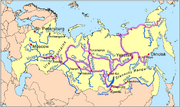| |||||
| Anthem | "по Урала, на Камчатку" | ||||
| Capital (and largest city) |
Novosibirsk | ||||
| Other cities | Ufa, Irkutsk | ||||
| Language | Siberia | ||||
| Religion main |
Eastern Orthodoxy | ||||
| others | Buddhism, Shamanism | ||||
| Demonym | Siberian | ||||
| Government | Republic | ||||
| Internet TLD | .sb | ||||
| Organizations | League of Nations | ||||
Siberia is a nation in northern Asia. It borders Russia, Mongolia, Alash, Manchuria, and China.
History[]
Sibir & Russian conquest[]

Yermak's troops invading Siberia
With the breakup of the Golden Horde late in the 14th century, the Khanate of Sibir was founded with its center at Tyumen. The non-Borjigin Taybughid dynasty vied for rule with the descendants of Shiban, a son of Jochi. In the beginning of the 16th century, Tatars from Turkestan began to inhabit the lowlands to the east of the Ural Mountains, founding the Kazan Khanate, in parts of what is now Siberia and Turkestan. Conflicts with the Russians, who were colonizing the Urals, brought both Tatar states into conflicts with Russia. The Russians won, thus getting a foothold in Siberia and the Volga region. In the 1570s the entrepreneur Semyon Stroganov and other sons of Anikey Stroganov enlisted many Cossacks for protection of the Ural settlements against attacks by Siberians. The chief Yermak was suggested to conquer the Siberian Khanate. In 1581, Yermak began his voyage into Siberia with a band of 1,636 men. They successfully laid siege to Qashliq, the residence of the Siberian Khan, and not too long after engaged in numerous victories against the Siberian armies. After a 3-day battle of Chuvash Cape in 1582, the remains of the khan's army retreated to the steppes, abandoning his domains to Yermak, who, according to tradition, presented Siberia to Tsar Ivan IV achieved his own restoration to favor.
Russian settlement[]

A map of river routes in Siberia
In the early 17th century, the eastward movement of Russian peoples were slowed by the Time of Troubles and internal problems. However, very soon, the colonization of large territories of Siberia continued, led mostly by Cossacks hunting for ivory and furs. While Cossacks came from the Southern Urals, another wave of Russians came by the Arctic Ocean, mostly ethnic Pomors from the Russian North. In 1620 a group of fur hunters led by the semi-legendary Demid Pyanda started out from Turukhansk on what would become a very protracted journey. According to folk tales related a century after the fact, in the three and a half years from 1620 to 1624 Pyanda allegedly traversed the total of 4,950 miles, mostly among unknown Siberian rivers. By doing this, he may have become the first Russian to reach Yakutia and meet ethnic Yakuts. He also may have become the first Russian to meet Buryats as well. The first Russian settlement in Buryatia, Rybinsky ostrog, was founded in 1631. Yakutsk eventually became a base for further eastward Russian expansion and colonization. By the mid-17th century the Russian people had established the borders of their country close to the modern ones, and explored almost the whole of Siberia, except eastern Kamchatka and some regions north of the Arctic Circle. The main treasure to attract Cossacks to Siberia was the fur of sables, foxes, and ermines. Explorers brought back many furs from their expeditions. Local peoples who submitted to Russia received defense from nomads from the south. The development of the Siberia was hampered by poor transportation links within the region as well as between Siberia and the rest of the country. The Trans-Siberian railway was built by Russian government ministers who were personally appointed by the tsars at the time. The Russian colonization of Siberia is also mostly responsible for their colonization of modern-day Alaska.
Revolution and modern Siberia[]
During the Russian Colonial War, Siberian troops, mostly natives, revolted against their Russian sovereigns. With support from some, foreign, anti-Russian nations and various other rebel groups in parts of Russia, Siberia managed to gain independence from the Russians. During this war, Siberian rebels also invaded Tuva, to their close relations to the ethnic Buryats and Mongols located in Siberia. Even though Siberia and allies ultimately won the war, Tuva ultimately lost no land and only a couple hundred troops to the Siberian aborigine forces. Today, Siberia is an agrarian, somewhat wealthy state which benefits from its location on the crossroads of Europe, Asia, and North America. Trade is also a large sector of the Siberian economy as the nation is extremely easy to access from numerous different parts of the world. Siberia has also sent troops to Primorsky in hopes of creating a free, ethnic Russian state in former Manchu lands. Siberia has on as far as to recognizing Primorsky as independent from Manchuria. However, a large percentage of the Russian majority wants a fusion between the two nations.
Demographics[]
Ethnic groups[]
| Number | Group |
|---|---|
| 1 | Russians |
| 2 | Ukrainians |
| 3 | Germans |
| 4 | Mongols |
| 5 | Uralic people |
Religion[]
| Number | Group |
|---|---|
| 1 | Eastern Orthodoxy |
| 2 | Buddhism |
| 3 | Shamanism |
| 4 | Islam |
| 5 | Catholicism |
| |||||||||



